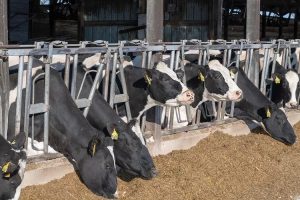
If you only read the first two words in this article, you would think that I am writing about a current political issue in the U.S. We have heard a lot about border control in recent years, but it is certainly a very political issue during this presidential election year.
However, I just used these two words to get your attention about the critical practice of biosecurity on dairy farms. Biosecurity can be defined as a series of management practices on an animal production facility to prevent the introduction or spread of disease agents.
We have focused on this for many years as we discussed having closed herds and quarantining sick or new animals entering the herd. However, attention to biosecurity for dairy farms was heightened in March when highly pathogenic avian influenza was diagnosed on two dairy herds in Kansas and one in Texas.
As a result, biosecurity has been a major focus for the dairy industry during the past five months to prevent the spread of HPAI among animals and humans.
In the August issue of the Journal of Dairy Science, Canadians researchers published a study titled “Ontario Dairy Producers and Veterinarians Perspectives: Barries to biosecurity implementation.” This study was conducted between July 2022 and January 2023 among 17 dairy producers and 18 veterinarians. Though the study was conducted prior to the HPAI outbreak in cattle in the U.S., it provides some attention-grabbing insights.
The researchers categorized the barriers to biosecurity implementation into four theme areas listed below and further itemized the key aspects within each theme.
Lack of resources
Financial barriers were perceived by both producers and veterinarians and included cost of testing, having boot washes or disposable boot covers and having a closed herd. An example of the cost of a closed herd was the need to raise their own heifers.
Time barriers were identified to complete the practices and paperwork required which took time away from other management practices. However, it was noted that producers recognized that the time for biosecurity practices could take less time than for treatment of sick animals.
Facility barriers were identified, such as having inadequate facility design to segregate animals and the financial aspect to needing to modify current facilities or building new space for housing.
Technological barriers were more of a focus by producers than veterinarians. The producers indicated that sometimes they are asked to implement technology that is expensive, not yet fully available or is unreasonable to implement.
Knowledge barriers included producers not fully understanding the purpose of some practices and the general lack of knowledge on biosecurity.
Internal and external business influencers. The positive impact on animal health included reducing the number of sick animals, reducing the use of antibiotics, increasing the longevity of the herd and improving the safety of the animals when chemicals are involved.
Cost benefits included financial gain from more productive animals, reduced cost of disease, selling better quality of animals and food safety.
Factors influencing change included whether the biosecurity measures were voluntary or mandatory.
Producers recognized that the effective implementation of biosecurity measures needed to include the collective approach of their veterinarian, nutritionist, employees and others involved with the operation.
Public perception was important by ensuring a positive image of agriculture.
Individual perceptions of biosecurity. The barriers in this theme included lack of value placed on biosecurity, perceived lack of disease risk and resistance to change.
Lack of industry initiative
This theme included the issue of employee compliance to biosecurity protocols, lack of biosecurity practiced with animal movement within the dairy industry, human movement on and off dairy farms, not all farmers perceiving the same level of risk and lack of attention to posted protocol measures by industry personnel traveling onto dairy farms.
The presence of HPAI in the U.S. has certainly highlighted the importance of biosecurity on dairy farms. Some of the obstacles to implementation certainly were identified in the Canadian study and became apparent during the past five months.
However, the dairy industry, regulatory agencies and universities have been working effectively together to address the issues relating to HPAI and the biosecurity measures needed. Additional resources on biosecurity for dairy farms is available from Ohio State (https://dairy.osu.edu/) and the Ohio Department of Agriculture (https://agri.ohio.gov/divisions/animal-health/hpai/dairy-cattle).
You can now read the most important #news on #eDairyNews #Whatsapp channels!!!
🇺🇸 eDairy News INGLÊS: https://whatsapp.com/channel/0029VaKsjzGDTkJyIN6hcP1K























